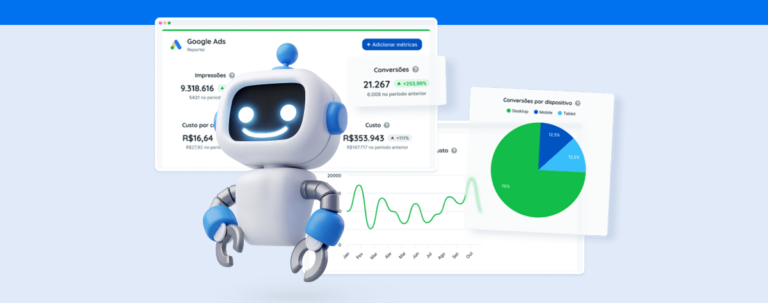Discover how A/B testing works for paid traffic and how to apply this strategy to achieve better results with ads
A/B testing has become an increasingly common practice in digital marketing, especially regarding paid traffic ads. With the growing online competitiveness, finding ways to improve campaign performance and ensure a return on investment (ROI) is crucial.
In this context, this testing model emerges as a powerful tool that allows marketing professionals to experiment with different elements in their ads and identify which strategies yield the best results.
In this article, we will explore how A/B testing can be applied to paid traffic ads, providing valuable insights to optimize your campaigns’ performance and increase conversions. Let’s dive in!
What are A/B Tests and Why are They Important in Paid Traffic Ads?
A/B tests are experiments conducted to compare two variants of the same page, ad, or element, to determine which one generates better results with the audience. In the context of paid traffic ads, this strategy is crucial for optimizing campaign performance and maximizing ad ROI.
Through such actions, marketing professionals have the opportunity to test different elements, like headlines, calls to action, images, colors, etc., and identify which elements generate higher engagement, clicks, and conversions.
This process allows access to data that enable more assertive decision-making and focusing resources and budget on the most efficient strategies.
Additionally, A/B tests help understand the target audience’s behavior and preferences. By conducting controlled experiments, it’s possible to discover which messages, styles, and approaches resonate best with users, aiding in creating more relevant and persuasive ads.
Continuous testing over time also allows for refining and adjusting campaigns, keeping up with changes in consumer demands and behaviors.
By adopting a data-driven and experimental approach, analysts can achieve superior performance in the highly competitive digital marketing environment.
How to Conduct A/B Testing in Paid Traffic Ads
Now that you know what A/B testing is and its importance for paid traffic, here are some tips to apply this strategy and obtain better insights to adjust your campaigns:
Setting Objectives and Hypotheses for A/B Tests
When conducting A/B tests in paid traffic ads, it’s essential to establish clear objectives and formulate solid hypotheses to guide testing and gain relevant insights about campaign performance.
First, define the general goal, such as increasing the click-through rate (CTR), conversions, improving cost per acquisition (CPA), etc. Having a purpose will help direct efforts and evaluate results accurately.
After this first step, it’s time to formulate hypotheses: well-founded assumptions about the expected performance of one variant over another.
For instance, you might assume that a more emotional headline will increase the click-through rate compared to a more descriptive one. Or perhaps you believe that an image featuring people will generate more engagement than an image with isolated products.
As with the goals, hypotheses should be clear, specific, and measurable, allowing for an objective evaluation of the results. Also, to formulate them, consider previous insights, historical data, and knowledge about the target audience. This will help guide them and ensure they are well-founded.
Remember to document your objectives and hypotheses before starting the tests and, afterward, analyze the results based on these definitions. This will allow for an appropriate evaluation and clear direction to optimize your paid traffic campaigns.
Key Elements to Test in Paid Traffic Ads
There are various key elements that can be tested to improve campaign performance. Below are some of the most common and significant ones that you should consider when planning your A/B tests:
- Headlines and Calls to Action (CTAs): Testing different headline variations can help identify which approach generates the most engagement. Moreover, CTAs are fundamental in encouraging users to take the desired action, whether it’s clicking on the ad, making a purchase, or filling out a form.
- Images and Videos: These elements significantly impact attractiveness and audience engagement. Therefore, testing them – by changing composition, style, colors, or highlighted elements – can help determine which visuals generate more engagement.
- Descriptive Text: This plays an important role in conveying the message and creating interest. Modifying the language, tone, or length can identify which approach connects better with the audience and generates more clicks or conversions.
- Colors and Design: Testing different color schemes, layouts, or visual elements can reveal insights about these elements’ impact on ad effectiveness.
- Audience Targeting: Beyond the creative elements themselves, targeting the audience can also be tested. Experimenting with different demographic segments, interests, or geographic locations can help identify which audience responds best to the ad, optimizing campaign targeting.
It’s crucial to test only one element at a time for clear and reliable results. Moreover, tracking the tested variants is essential to make necessary adjustments and ensure optimal performance of paid traffic campaigns.
Planning and Executing Effective A/B Tests
Planning and executing A/B tests involves not only defining objectives, hypotheses, and tested elements but also:
- Determining Sample Size: To obtain statistically significant results and data for efficient analysis.
- Creating Test Variants: Ensuring the variants are distinct enough for differences to be easily identified and measured.
- Monitoring and Data Collection: For accurate tracking during the test period.
- Analyzing Results: Evaluate each variant’s performance. Compare conversion rates, click-through rates, or other relevant metrics, checking if observed differences are statistically significant and either confirm or refute your initial hypotheses.
- Decision-Making and Implementation: Based on the test results, implement changes from the better-performing variant.
Continuous A/B testing is vital to ensure campaign performance. Repeat this process of planning, executing, and analyzing regularly, continually refining your ads for better returns.
Analyzing Results and Refining Campaigns
Finally, after conducting A/B tests in paid traffic ads, it’s crucial to perform a thorough analysis of the results to extract significant insights and refinements for campaigns. Here are the steps to follow:
- Evaluate Relevant Metrics: Examine those defined earlier, like click-through rate (CTR), conversion rate, cost per acquisition (CPA), and other data relevant to your goal. Compare the performance of different tested variants and identify those that performed best.
- Consider the Context: Analyze results within the broader context of the campaign and audience. Consider factors like seasonality, consumer behavior, and demographic characteristics. These insights can help provide a more comprehensive understanding of the variants’ performance.
- Learn from Insights Gained: Draw conclusions from the A/B tests and analyzed results. Identify emerging patterns and trends, such as specific elements that led to significant performance improvements. Apply these insights for future campaign refinements and ongoing optimization.
- Implement Changes: Based on the obtained results, implement the most effective changes. Integrate the winning variants into ongoing campaigns or use them as a basis to create new approaches for further performance enhancement.
- Continuously Monitor: Results analysis should not be a one-time process. Constantly track campaign performance and use regular A/B tests to continue refining and optimizing your ads.
- Document and Share Learnings: Record the insights for future reference. Keep a history of best practices discovered, variants that generated the highest return, and lessons learned throughout the process, sharing these learnings with your team.
By analyzing the results of A/B tests and refining your campaigns based on the insights gained, you’ll be strengthening your marketing strategy and maximizing the performance of your paid traffic ads.
Generate More Efficient Paid Traffic Reports with Reportei
For more precise analyses of your A/B testing strategy in paid traffic ads, you can rely on Reportei’s reports and dashboards!
In addition to integrating with the leading ad platforms in the market – such as Google, Facebook, TikTok, LinkedIn, and many more – our tool captures metrics and generates reports in just a few seconds, helping you dedicate time to what matters most: evaluating the return obtained and making more strategic decisions.
Along with this, you can document all your planning, execution, and analysis in the Marketing Timeline, creating an efficient record for future A/B tests.
Take advantage of our 3-day free trial period and discover how Reportei can help make your digital marketing actions more efficient!





